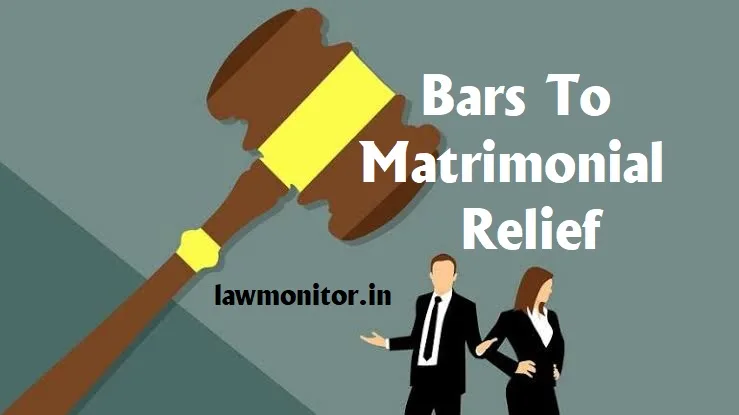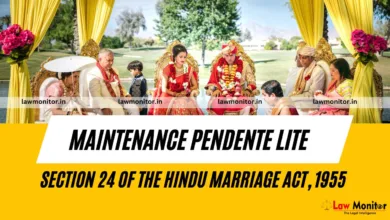Bars to Matrimonial Relief PDF: Short Notes with Details
In India, where a variety of personal laws govern matrimonial issues, understanding the intricate concept of "bars to matrimonial relief" becomes essential.

In this article we talk about Bars to Matrimonial Relief and also given Short Notes PDF with Detail. To read Short notes download the PDF and details is given in this article, so let’s begin
Marriage, a sacred union, can sometimes face difficulties that prompt individuals to seek legal intervention. In India, where a variety of personal laws govern matrimonial issues, understanding the intricate concept of “bars to matrimonial relief” becomes essential.
Meaning of Bars to Matrimonial Relief
Bars to matrimonial relief refer to legal obstacles that can prevent someone from obtaining remedies like divorce under specific personal laws. These restrictions cover various issues such as connivance, condonation, collusion, adultery, cruelty, desertion, or unreasonable delays.
Examples:
- Indian Divorce Act, 1869: Outlines bars for Christians.
- Parsi Marriage and Divorce Act, 1936: Specifies conditions like annulment, condonation, and delay.
Importance and Purpose of Bars to Matrimonial Relief
Bars to matrimonial relief play a key role in maintaining the integrity and fairness of legal processes governing marriages. These bars act as safeguards within personal laws, ensuring that individuals seeking relief meet established criteria. By defining conditions such as connivance, condonation, and collusion, these restrictions prevent the misuse of legal provisions and promote just outcomes.
The purpose of these bars is to uphold the sanctity of marriage and maintain ethical standards, discouraging parties from improperly exploiting legal avenues. By outlining specific prerequisites for obtaining relief, these bars contribute to the fair resolution of matrimonial disputes, promoting transparency and preserving the legitimacy of legal interventions in marital matters.
Bars to Matrimonial Relief under Hindu Law
The Hindu Marriage Act, 1955
The Hindu Marriage Act, 1955, specifies conditions that must be met to obtain matrimonial relief. These conditions, based on the Doctrine of Equity, emphasize that those seeking relief must approach with clean hands, demonstrating the fault of the other party.
Section 23 of the HMA lists the bars to matrimonial relief. If the party seeking relief violates clauses (a) to (e) of Section 23(1), the request for relief will be denied. Any court order contrary to these bars is null and void. The specific bars include:
| Daily current affairs Updates | Click Here |
| Law Notes Free Channel | Click Here |
Burden of Proof:
Matrimonial cases adhere to the doctrine of strict proof. The aggrieved party must prove allegations related to maintenance, child custody, etc. In divorce proceedings, the burden of proof lies with the petitioner. The case of Dastane v. Dastane (1975) highlighted that the burden of proof need not be beyond a reasonable doubt.
Taking Advantage of One’s Own Wrong:
If the aggrieved party exploits their own wrongdoing, the court will not grant matrimonial relief. This provision is unique to the Hindu Marriage Act of 1955.
Accessory:
Section 23(1)(b) introduces the term “accessory,” typically used in criminal cases. If the petitioner is involved in or aids the respondent in an immoral or criminal act, matrimonial relief will not be granted. This restriction specifically pertains to adultery under the Hindu Marriage Act.
Connivance:
Connivance involves participation in an immoral or wrongful act. If the petitioner encourages the wrongful act of the respondent, they become ineligible for relief.
Condonation:
Condonation involves forgiving a crime committed by the offender. The court examines whether the petitioner has forgiven the act committed by the respondent, especially in cases of cruelty or adultery.
Collusion:
Section 23(1)(c) addresses the bar of collusion, an absolute prohibition under the Hindu Marriage Act, 1955, and the Special Marriage Act, 1954. Collusion refers to an agreement between parties to obtain matrimonial relief by deceiving or misrepresenting the court or producing false evidence. The petitioner must prove there is no collusion.
Delay:
Unnecessary delays are not tolerated in matters of matrimonial relief. The petitioner must prove that any delay was not intentional. This bar is based on the doctrine of Laches, which disallows filing a suit due to unreasonable delay.
Other Legal Grounds:
Section 23(1)(e) states that matrimonial relief will not be granted if any other legal grounds exist that restrict such relief.
Reconciliation:
Section 23(2) requires the court to attempt reconciliation between the parties. However, reconciliation does not apply in cases where divorce is sought on grounds like leprosy, conversion, insanity, venereal disease, renunciation, or presumption of death.
Irretrievable Breakdown of Marriage as a Bar to Matrimonial Relief
In its 71st report in 1980, the Law Commission recommended introducing irretrievable breakdown of marriage as a new ground for divorce under Hindu law. This would allow either spouse to file for dissolution if the marriage has irretrievably broken down. The Commission proposed specific bars to this ground:
Financial Hardships for the Wife:
If the wife is the respondent, she can reject the dissolution by asserting that it will cause financial hardship.
Court Examination and Considerations:
The court must examine the facts, circumstances, and interests of both parties and their children. If the court determines that dissolution will cause financial hardships, it can dismiss the petition or suspend proceedings until arrangements are made to mitigate these hardships.
Maintenance of Children:
The court will not grant a decree for dissolution based on irretrievable breakdown until provisions for the maintenance of children are secured, considering the financial capacity of the parties.
The Law Commission recommended that this bar to matrimonial relief should not fall within the scope of Section 23(1)(a) of the Hindu Marriage Act, 1955. Although the Government initially accepted these recommendations, they lapsed due to strong opposition.
Key Case Laws on Bars to Matrimonial Relief
Nitaben Dinesh Patel v. Dinesh Dahyabhai Patel (2021)
In this case, the husband filed for divorce under Section 13 of the Hindu Marriage Act (HMA), alleging cruelty by his wife. The wife, in turn, claimed that she and their son had been abandoned without adequate support. She also argued that the husband’s current cohabitation and subsequent marriage were illegal, which would illegitimize their son. The Supreme Court determined that relief under Section 23A of the HMA could not be granted for such claims. Counterclaims must align with the reliefs specified in Sections 9 to 13 of the HMA.
Smt. Leela v. Dr. Rao Anand Singh & Anr. (1963)
Here, the respondent, Anand Singh, was already married to Smt. Roopwati Devi before marrying the appellant, Smt. Leela, who converted to Hinduism for their marriage. Smt. Leela filed a petition claiming that the respondent had concealed his first marriage, treated her cruelly, and deserted her. The court evaluated:
- The concealment of the first marriage, which the respondent admitted.
- Allegations of cruelty.
- The delay in filing the petition under Section 23(1)(d) of the HMA.
The court concluded that the delay was not unjustified and could not be used to dismiss the case. The key issues of concealment, cruelty, and the legitimacy of the filing were addressed, highlighting that delay alone was not a sufficient ground for rejection.
Special Marriage Act, 1954
Section 34 – Grounds for Granting Relief:
Section 34 outlines the conditions under which the court may grant relief, including:
- Accessory
- Connivance
- Condonation
- Collusion
- Unnecessary delays
- Burden of proof
- Ensuring consent in mutual consent divorces is not obtained by force or fraud
- Any other legal grounds
- Reconciliation
While the Special Marriage Act and the Hindu Marriage Act share similarities, they serve different purposes. The Hindu Marriage Act is specific to Hindus in India and follows Hindu traditions. Conversely, the Special Marriage Act is inclusive of all citizens, regardless of religion, caste, or ethnicity, and does not require adherence to specific rituals.
Case: K. Ramaswamy v. Esther Johney (1987)
In this case, the couple married under the Special Marriage Act, 1954. The appellant, Ramaswamy, claimed the marriage was invalid due to coercion and that the respondent, Esther Johney, was underage. The respondent denied these allegations. The District Court noted an unnecessary delay in filing the petition, which was upheld by the Madras High Court. The delay exceeded two years, which under the Act constituted an unnecessary delay, leading to the rejection of the appellant’s claim.
Bars to Matrimonial Relief under Other Personal Laws
Muslim Personal Law
Muslim Personal Law currently does not specify explicit bars to matrimonial relief.
Indian Divorce Act, 1869 (Christians)
The Indian Divorce Act, 1869, governs Christian divorces and outlines bars to matrimonial relief in Sections 12 and 14:
- Section 12 examines if the petitioner was involved as an accessory, in connivance, condonation, ongoing cohabitation, or adultery.
- Section 14 allows the court to dissolve the marriage unless the petitioner is guilty of adultery, cruelty, desertion, or unreasonable delay.
Parsi Marriage and Divorce Act, 1936 (Parsis)
This Act governs Parsi marriages and divorces, with Section 35 outlining bars to matrimonial relief such as:
- Annulment
- Condonation
- Collusion
- Connivance
- Reasonable delay
- Any other legal ground
If the court finds the petitioner does not meet the specified bars, it can grant matrimonial relief. Parsi marriages are recognized as contractual and validated through the Ashirwad ceremony.
Download Short Notes PDF
Conclusion
Understanding the bars to matrimonial relief is crucial for seeking justice within India’s diverse personal laws. Parties must be aware of and comply with these legal conditions, recognizing their nuanced implications. Upholding the sanctity of marriage remains a cornerstone, ensuring matrimonial remedies are pursued and granted within an ethical and just framework.




